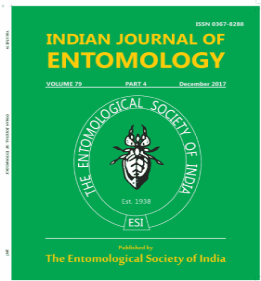Enhancement of Mating Performance of Sterile Males of Melon Fly,Zeugodacus cucurbitae (Coquillett) Through Methoprene and Cue Lure
DOI:
https://doi.org/10.55446/IJE.2023.966Keywords:
Zeugodacus cucurbitae, methoprene, cue lure, yeast hydrolysate, mating parameters, lek intiation, lek participation, male calling, female acceptance indexAbstract
The male pupae of Melon fly, Zeugodacus cucurbitae were irradiated at 30 Gy of gamma radiation using Cobalt-60 source. Freshly emerged sterile males (30 Gy) were exposed to different regimes of methoprene and yeast hydrolysate as protein source. Sterile males of 10, 12 and 14 days old were exposed to different regimes of cue lure and yeast hydrolysate. Mating parameters such as lek initiation, lek participation, male calling, mating success and female acceptance index (FAI) were recorded. Sterile males of exposed to methoprene and fed with yeast hydrolysate (M+P+) become sexually matured at three days earlier when compare to protein deprived males (M+P-). High percentage of M+P+ males were engaged in lekking and calling behavior. Sterile males treated with methoprene and fed on protein diet had high percentage of matings with female acceptance index (FAI) of 0.8. Sterile males fed on yeast hydrolysate up to 12-days of age and then accessed to cue lure (P+CL+) had greater mating propensity with frequent mating (43.0%) and FAI of 0.84.
Downloads
Metrics
Downloads
Published
How to Cite
Issue
Section
References
Aluja M, Jacome I, Macias-Ordonez R. 2001. Effect of adult nutrition on male sexual performance in four neotropical fruit fly species of the genus Anastrepha (Diptera: Tephritidae). Journal of Insect Behavior 14(6): 759-775.
Bachmann G E, Devescovi F, Nussenbaum A L, Cladera J L, Fernendez P C, Vera M T, Teal P E A, Segue D F. 2017. Male sexual enhancement after methoprene treatment in Anastrepha fraterculus (Diptera:Tephritidae): A sustained response that does not fade away after sexual maturation. Journal of Insect Physiology 101: 7-14.
Badii K B, Billah M K, Afresh-Nuamah K, Obeng-Ofori D, Nyakro G. 2015. Review of the pest status, economic impact and management of fruit-infesting flies (Diptera: Tephritidae) in Africa. African Journal of Agricultural Research 10(12): 1488-1498
Collins S R, Reynols O L, Taylor P W. 2015. Combined effects of dietary yeast supplementation and methoprene treatment on sexual maturation of Queensland fruit fly. Journal of Insect Physiology 61: 51-57.
De Meyer M, Delatte H, Mwatawala M, Quilici S, Jean-Francois V, Virgilio M. 2015. A review of the current knowledge on Zeugodacus cucurbitae (Coquillett) (Diptera: Tephritidae) in Africa, with a list of species included in Zeugodacus. Zoo Keys 540: 539-557.
Haq I U, Vreysen M J B, Schutze M, Hendrichs J, Shelly T. 2016. Effects of methyl eugenol feeding on mating compatibility of Asian population of Bactrocera dorsalis (Diptera: tephritidae) with African population and with B. carambolae. J Econ Entomol 109(1): 148-153.
Hendrichs J, Robinson A S, Cayol J P, Enkerlin W. 2002. Med fly area wide sterile insect technique programmes for prevention, suppression or eradication: The importance of mating behavior studies. Florida Entomologist 85(1): 1-13.
Iwahashi O, Majima T. 1986. Lek formation and male-male competition in the melon fly, Dacus cucurbitae (Diptera: Tephritidae). Applied Entomology and Zoology 21(1): 70-75.
Jang E B, Mcinnis D O, Lance D R, Carvalho L A. 1998. Mating-induced changes in olfactory mediated behavior of laboratory-reared normal sterile and wild female Mediterranean fruit flies (Diptera:Tephritidae) mated to conspecific males. Annals of Entomological Society of America 91(1): 139-144.
Joachim-Bravo I S, Anjos C S, Costa A M. 2009. The role of protein in the sexual behaviour of males of Ceratitis capitata (Diptera: Tephritidae): mating success, copula duration and number of copulations. Zoologia 26(3): 407-412.
Kapoor V C. 2005. Taxonomy and biology of economically important fruit flies of India. Israel Journal of Entomology 6(35-36): 459-475.
Kaspi R, Taylor P W, Yuval B. 2000. Diet and size influence sexual advertisement and copulatory success of males in Mediterranean fruit fly leks. Ecological Entomology 25(3): 279-284.
Khoo C C H, Tan K H. 2000. Attraction of both sexes melon fruit fly, Bactrocera cucurbitae, to conspecific males – a comparison after pharmacophagy of cue-lure and a new attractant–zingerone. Entomologia Experimentalis et Applicata 97(3): 312-320.
Knipling EF. 1979. The basic principles of insect population suppression and management. USDA Agriculture Handbook. 512pp.
Kuba H, Sokei Y. 1988. The production of pheromone clouds by spraying in the melon fly, Dacus cucurbitae (Diptera:Tephritidae). Journal of Ethology 6: 105-110.
Liendo M C, Devescovi F, Bachmann G E, Utges M E, Abraham S, Vera M T, Lanzavecchia S B, Bouvet J P, Gomez-Cendra P, Hendrichs J, Teal P E A, Cladera J L, Segura D F. 2013. Precocious sexual signaling and mating in Anastrepha fraterculus (Diptera: Tephritidae) sterile males achieved through juvenile hormone treatment and protein supplements. Bulletin of Entomological Research 103(1): 1-13.
Obra G B, Resilva S S. 2011. Influence of adult diet and exposure to methyl eugenol in the mating performance of Bactrocera philippinensis. Journal of Applied Entomology 137(1): 210-216.
Orankanok W, Chinvinijkul1 S, Sawatwangkhoung A, Pinkaew S, Orankanok S. 2011. Methyl eugenol and pre-release diet improve mating performance of young Bactrocera dorsalis and Bactrocera correcta males. Journal of Applied Entomology 137(1): 200-209.
Panduranga G S, Sharma K, Sharma R K. 2018. Evaluation of artificial larval diets for mass rearing of Bactrocera cucurbitae (Coq.). Indian Journal of Biochemistry and Biophysics 55: 125-131.
Pereira R, Sivinski J, Teal P E A. 2009. Influence of methoprene and dietary protein on male Anastrepha suspensa (Diptera: Tephritidae) mating aggregations. Journal of Insect Physiology 55(4): 328-335.
Perez-Staples D, Harmer A M T, Collins S R, Taylor PW. 2008. Potential for pre-release diet supplements to increase the sexual performance and longevity of male Queensland fruit flies. Agricultural and Forest Entomology 10(3): 255-262.
Perez-Staples D, Prabhu V, Taylor P W. 2007. Post-teneral protein feeding enhances sexual performance of Queensland fruit flies. Physiological Entomology 32(3): 225-232.
Segura D F, Caceres C, Vera T M, Wornoayporn V, Islam A, Teal P E A, Cladera J L, Hendrichs J, Robinson A S. 2009. Enhancing mating performance after juvenile hormone treatment in Anastrepha fraterculus: a differential response in males and females acts as a physiological sexing system. Entomologia Experimentalis et Applicata 131: 159-166.
Shelly T E, Villalobos E M. 1995. Cue lure and the mating behavior of male melon flies (Diptera: Tephritidae). Florida Entomologist 79(4): 481-488.
Shelly T E, Edu J, Pahio E. 2005. Influence of diet and methyl eugenol on the mating success of males of the oriental fruit fly, Bactrocera dorsalis (Diptera: Tephritidae). Florida Entomologist 88(3): 307-313.
Shelly T E, Resilva S S, Reyes M R, Bignayan H G. 1996. Methyl eugenol and mating competitiveness of irradiated male Bactrocera philippinensis (Diptera:Tephritidae). Florida Entomologist 79(4): 481-488.
Taylor P W, Yuval B. 1999. Postcopulatory sexual selection in Mediterranean fruit flies: advantages for large and protein-fed males. Animal Behavior 58: 247-251.
Teal P E A, Gomez-Simuta Y, Proveaux A T. 2000. Mating experience and juvenile hormone enhance sexual signaling and mating in male Caribbean fruit flies. The Proceedings of the National Academy of Sciences USA. 97(7): 3708-3712.
Teal P E A, Gomez-Simuta Y, Duebeni B D, Holler T C, Olson S. 2007. Improving efficacy of the sterile insect technique by incorporating of hormone and dietary supplements into adult holding protocols. Vreysen MJB, Robinson AS, Hendrichs J, In: Area-wide control of insect pests from research to field implementation. Springer, Dordrecht, the Netherlands. 163 pp.
Viraktamath C A, Mallik B, Chandrashekar S C, Ramakrishna B V, Praveen H M. 2003. Insect pests and diseases on Gherkins and their management. Technical Bulletin University of Agricultural Sciences, Bangalore, India. 65pp.
Vreysen M J B, Hendrichs J, Enkerlin W R. 2006. The sterile insect technique as a component of sustainable area-wide integrated pest management of selected horticultural insect pests. Journal of Fruit and Ornamental Plant Research 14(3): 107-131.
Warburg M S, Yuval B. 1997. Effects on energetic reserves on behavioural patterns of Mediterranean fruit flies. Oecologia 112: 314-319.
Wee S L, Tan K H, Nishida R. 2007. Pharmacophagy of methyl eugenol by males enhances sexual selection of Bactrocera carambolae (Diptera: Tephritidae). Journal of Chemical Ecology 33: 1272-1282.
Yuval B, Kaspi R, Field S A, Blay S, Taylor P W. 2002. Effects of post-teneral nutrition on reproductive success of male Mediterranean fruit flies (Diptera: Tephritidae). Florida Entomologist 85: 165-170.
Yuval B, Kaspi R, Shloush S, Warburg M S. 1998. Nutritional reserves regulate male participation in Mediterranean fruit fly leks. Ecological Entomology 23: 211-215.
















